
LET US BUILD A
STEREOSCOPE
Giorgio Carboni, April 1996
English version
revised by Ed Vogel
INTRODUCTION
The stereoscope is a simple optical instrument which allows us to see in
relief drawings and photographs. For us, to see in three dimensions a solid
body, is a fact so natural that we do not even take it into account. Also it is
normal to see "flat", that is to say lacking a third dimension; drawings or
pictures. Did you ever ask yourself why this occurs? The phenomena is so natural
and obvious that many people do never pay attention to it. For trying to
understand how this happens, make this experiment: while observing a solid
object, as a bottle or a chair, cover an eye with a hand. Even in this case, the
image will lose third dimension. It is true that some clues remain, as shapes
and the variation of size with distance, which help you to have an idea of
volume of things and their position in the space. Nevertheless, using an eye
only, you lack depth perception. If you want to touch an object, it can occurs
you are wrong. Removing the hand that covers the eye, you will see return the
third dimension of the space and of the objects which are on it.
The ability
of viewing bodies in relief is defined stereoscopic sight. It is due to the
interaction of the two eyes. Each eye watches an object from a different
direction by rapport the other, and get from it a slightly different image. The
geometrical differences between the two images are used by the brain for drawing
the perception of deepness. This skill is been developed particularly by the
predatory animals which must evaluate precisely the distance of the prey.
Primates, from which man descends, developed stereoscopic vision for the
necessity of evaluating exactly the position of the branch to which grasp during
moving on the forest trees.
Now it should be evident why drawings and pictures are lacking of depth: this occurs because both the eyes receive the same image. Since there are not geometrical differences between what each eye perceives, the brain cannot extract the information of the third dimension.
Is it possible to give the volume to drawings and photographs? Is it possible to view in three dimensions imaginary objects as drawings? Is it possible to obtain the volume starting from two pictures both of them flat? Of course, and you can get very impressive stereoviews. In this section, we will see how it is possible to take 3D pictures and, above all, we will see how build some apparatus for their observation.
For making photographs in three dimensions, you need two images of the same object, but they must be taken from a different direction the one from the another. You can keep the corner which separate this two views similar to the one formed by the eyes, or even greater (hyperstereoscopy) for objects poor in plasticity. For obtaining 3D pictures, professional photographers use special cameras with two objectives. If you have not a camera of this type, especially designed for stereophotography, you can use also a normal camera. As showed in figure 1, you need take two subsequent pictures by displacing a little the camera between one shot and the other.
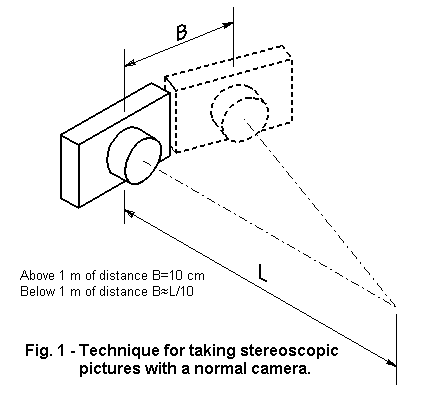 |
While you made so, move the camera parallely,
keeping it pointed towards the main subject. Take care avoiding vertical
differences in the framing. Obviously, this system is right for steady
objects only. For taking 3D photograph of moving things, you need to use
two cameras, to shoot together. You can also to use an accessory to fit on
the objective of a camera in order to transform it in a stereoscopic
camera. In this manner each 24x36 mm image on the film, will be divided in
a couple of 24x18 mm stereograms.
You can see in 3D also drawings. For obtaining that, you need made two perspective or axonometric views from two different directions. When you are drawing with the computer (CAD), you can make this operation easily, by obtaining the two stereograms simply rotating the drawn object. |
METHOD AND INSTRUMENTS FOR STEREOSCOPIC
OBSERVATIONS![]()
The last figures of this article have been obtained with methods as those we described. Now, we have the two images (or stereograms) for the stereoscopic view, how can we observe them in a suitable way? You must see at the same time both stereograms, one by the right eye, the other by the left one. It is not easy to see a thing with an eye and another thing with the other eye without to be inured to it (a chameleon would look at us with commiseration). It is at this point that the stereoscope enters in the field and shows its importance. The stereoscope is a simple optical apparatus which make easier the reassembling the two stereograms in an unique tridimensional view.
Thereafter we will deal with four techniques for observing stereograms:
1 - with naked eye (images up to 6x9 cm);
2 - with a simple stereoscope
(images up to 6x9 cm);
3 - with stereoscope for slides;
4 - with a mirror
stereoscope (images of great size).
Keep side by side the two stereograms which should not exceed 6x9 cm. Put the couple close to the eyes, in contact with your nose. At this moment each eye sees the stereogram that is in front. As a consequence, you see an unique image, extremely blurred. Do not try to focus it. Move the sheet with the stereograms 10 cm away from your eyes and stop. Now you should see three images, very out of focus. Every eye sees two of them, but the central one is due to the fusion of the two "internal" ones. If the central image should dissociate a little, wait relaxing the eyes until the two parts overlap exactly. Now, slowly move away again the sheet until the central image will be distinct. If the central image tend to dissociate, make a pause and wait that it overlaps. When you will see the central image clear and well fused, it will appear to you in three dimensions, as hanging in the space. It will seem to you that the support of paper on which the stereograms are lying is vanished. The effect is astonishing. The first time, to succeed in the task of viewing a stereoscopic image without using instruments is difficult, but the subsequent ones will be much easier. If this is the first time you try it, make a copy in a reduced scale of drawing, in order to facilitate the goal.
Remember that scientific magazines as Science and Nature often report stereoscopic drawings of molecules. This magazines do not give instruction on the method for their observation, as great is the familiarity of the readers towards the stereoscopic representations. In fact, most of those people are able to observe stereoviews even by naked eye. The use of reading spectacles can facilitate this operation.
There are people who do not succeed in the task we described and, after a lot of useless attempts, they abandon. Especially for these person a stereoscope (fig. 2) is useful. It consists in a very simple instrument, in which the central wall and the lenses facilitate the superimposition of two parts in an unique 3D image. The stereoscope we have shown features a removable bottom. This allows you to put the instrument on a magazine carrying stereograms, without have to cut it. The stereoscope is also disassemblable for facilitating its transport and conservation.
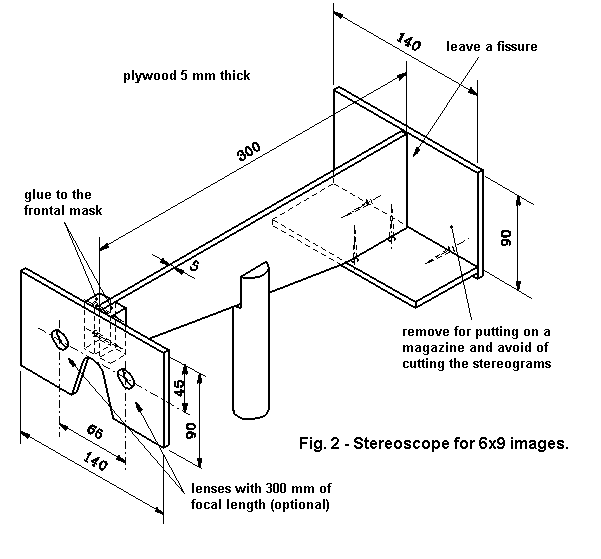
You can mount on the instrument two magnifying lenses with a focal length of 30 cm, for people of normal sight. Myops prefer weaker lenses or nothing. On the contrary, presbyops prefer stronger lenses. A stereoscope with lenses is easier to use, but they are not indispensable. In fact the muscles which drive the convergence of the eyes and those which regulate focusing, even if they are distinct, are accustomed working together. While observing stereograms, we ask to the eyes to keep parallel, as they were watching something distant, whilst they must focus at 30 cm of distance. The magnifying lenses make easier this operation because they allow to keep eyes adjusted to the infinity while they are observing near objects. Lacking these lenses, you can use reading spectacles as well. In any case, many people are able to use successfully the stereoscope even if it lacks of lenses and without using spectacles.
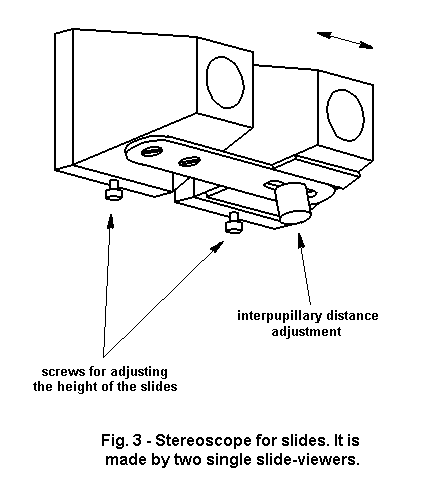 |
How can you view stereoscopic slides you obtain
by the technique showed in figure 1? You need built a stereoscope for
slides. It is an instrument very simple to carry out: it is a question of
putting two single slide-viewers side by side (fig. 3).
As you can see, the two viewers are mounted on an opened stirrup in order to allow modifying their distance and fitting it to the interpupillary distance of the observer. Notice the plastic stripes glued under the right viewer for keeping it aligned. A screw placed under each slide has the function of regulating the framing in the vertical direction. This method is the simplest to use among those described. With it, even people which have difficulties with the first two method described, are able to observe stereoscopic images. |
| Using the stereoscope of figure 2, the images
cannot be larger of interpupillary distance (about 6 cm), otherwise the
eyes would be forced to diverge. Our eyes easily can converge (observation
of near objects), or at the most to stay parallel (observation of distant
objects), whereas they have great difficulties in diverging. Hence, for
observing stereograms of large size, you need of a different instrument,
as the one showed into figure 4.
This stereoscope is made up by four mirrors. It could work also with the two central mirrors only, provided you agree that the stereoview appears to you specular by rapport to the stereograms. If you want avoid this disadvantage, you must prepare the stereograms in their turn specular by rapport the original. But this is an useless complication which you can avoid introducing in the instrument two other mirrors: the lateral ones, which erect the image. |
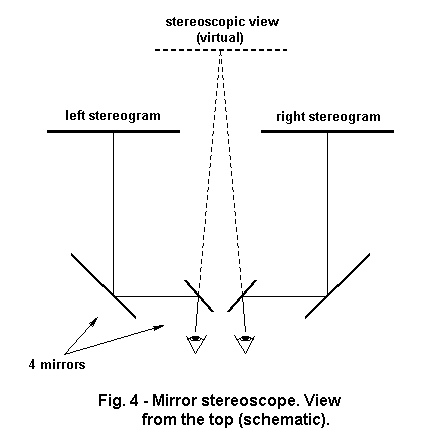 |
The mechanism of sight in relief is innate and works even in people who use it rarely or never such as squinters. Conversely there exist also normal people, not squinting, who do not possess the tridimensional sight of reality. Simply they have not this ability that for other people is so normal as to be easily forgotten.
Here some stereoscopic images. Instead of seeing them directly on the monitor, print them and reduce their size so that between the homologous points of two stereograms you have not more than 6 cm: the normal interpupillary distance. It is better you make the first attempts with a copy in a reduced scale. For the stereoscopic viewing of this images, follow the suggestion of the paragraph 1.

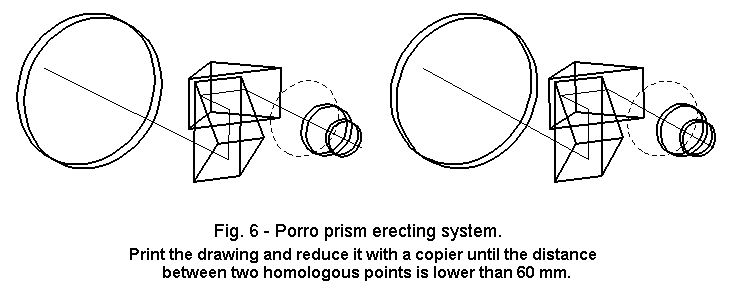
---o---o---o---0---o---o---o---0---o---o---o---0---o---o---o---0---o---o---o---
Send your opinion on the article
---o---o---o---0---o---o---o---0---o---o---o---0---o---o---o---0---o---o---o---